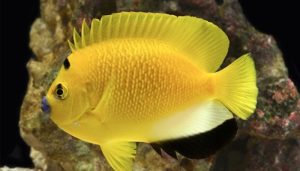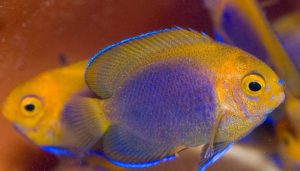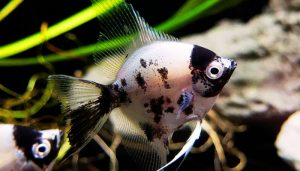Can Angelfish live with Bettas? Many fish keepers love both species, but is it a good idea to house them together? What factors determine their compatibility in a shared tank?
The short answer is that Angelfish and Bettas are not the best tank mates. Angelfish grow larger and can be aggressive, while Bettas are territorial and may attack long-finned fish. However, with a spacious tank, proper setup, and careful selection, they might coexist peacefully.
But there’s more to consider before you decide. Water parameters, tank size, and individual fish temperament play crucial roles. Let’s explore expert advice and the best strategies to create a harmonious aquarium for these beautiful yet challenging companions!
Table of Contents
ToggleCan Angelfish Live with Bettas?
Can angelfish live with betta fish? Angelfish and bettas can potentially live together in a well-planned aquarium, but their compatibility largely depends on individual personalities and tank conditions. Both species exhibit territorial behaviors, particularly male bettas, which can lead to aggression.
However, if the aquarium is spacious, typically at least a 20-gallon tank, and includes plenty of hiding spots, angelfish and bettas can coexist peacefully.
It is crucial to monitor their interactions closely, as the aggressive tendencies of male bettas may surface, especially if they feel threatened or crowded. In contrast, female bettas are generally more docile and could possibly get along better with angelfish.
Ensuring that the tank is big enough to accommodate both species is vital. Angelfish can grow larger than bettas, which can create a power dynamic in the tank. While some fishkeepers have reported success with angelfish and male bettas living together, it is not universally recommended.
It is essential to provide enough space and environmental enrichment to help these fish thrive and minimize stress. Ultimately, the success of keeping angelfish with bettas relies heavily on the individual personalities of the fish and the overall setup of the aquarium.
How Can Betta Fish and Angelfish Live Together?
To successfully house betta fish and angelfish together, a well-structured aquarium environment is essential. Start with a sufficiently large tank, ideally 20 gallons or larger, to provide ample swimming space.
Incorporating live plants and various decorations will create hiding spots, allowing both fish species to retreat when feeling threatened.
It is also important to monitor the water parameters, including temperature and pH levels, as both species thrive in similar conditions. Maintaining a stable environment helps reduce stress and aggression, fostering a more peaceful coexistence.
Additionally, introducing the fish gradually can ease tensions. Place the betta fish and angelfish in a separate tank for a few days before introducing them to the main aquarium. This acclimation period will help them adapt to the new environment and reduce stress when they finally share the tank.
Observing their behavior closely after introduction is crucial. If aggression arises, consider rearranging the tank décor to disrupt territorial claims or separating the fish if necessary. By taking these steps, fishkeepers can increase the chances of bettas and angelfish living together harmoniously.
What Fish Cannot Live with Angelfish?
While angelfish can be kept with various tank mates, certain fish species are best avoided due to their compatibility issues. For instance, goldfish should never be housed with angelfish, as they thrive in cooler water and have different dietary needs.
Additionally, territorial and aggressive fish species like some cichlids can pose a threat to the more peaceful angelfish, leading to stress and potential injury. Similarly, small fish like guppies or neon tetras may be seen as prey, especially by larger angelfish, making them unsuitable betta fish tank mates.
It is also advisable to avoid keeping angelfish with fin-nipping species like certain barbs or aggressive fish that might provoke stress. Bottom feeders such as kuhli loaches or catfish can work well, but it’s crucial to ensure they are not overly aggressive or territorial.
The key is to carefully research each species’ behavior and compatibility before adding them to the aquarium. By selecting compatible tank mates, fishkeepers can create a thriving community that allows angelfish to flourish without undue stress or aggression.
What Fish Lives Best with Bettas?
When considering tank mates for betta fish, it’s essential to select peaceful species that can coexist harmoniously. Many fish species live well with bettas, such as corydoras catfish, which are bottom feeders that help maintain a clean tank.
Additionally, smaller schooling fish like neon tetras or rasboras can thrive alongside male bettas, provided the tank is spacious enough. Female betta fish can also be introduced to create a betta sorority, where multiple females can coexist, although careful monitoring is still necessary to prevent aggression.
Another excellent option includes gourami, which share similar temperaments with bettas and can peacefully inhabit the same aquarium.
However, always ensure that the tank is adequately sized, as both bettas and their potential tank mates need enough space to swim and establish their own territories. The key to successful cohabitation is to select fish that are not overly aggressive and to provide plenty of hiding spots and visual barriers in the tank.
With proper planning and selection, you can create a thriving community tank that includes betta fish and other compatible species.
Why Is My Angelfish Killing Other Fish?
Angelfish can exhibit aggressive behavior under certain conditions, which may lead to them harming or killing other fish in the aquarium. This aggression often stems from territorial instincts, especially if the tank is overcrowded or lacks adequate hiding spots.
Angelfish are known to be protective of their space, and when they feel threatened, they may resort to aggressive behavior. If new fish are introduced without proper acclimatization or if there are not enough hiding spots, angelfish may perceive them as intruders and act aggressively.
Moreover, environmental stressors such as poor water quality, inadequate tank size, or fluctuating temperatures can exacerbate aggressive tendencies in angelfish.
If you notice your angelfish attacking other fish, it’s essential to assess the tank conditions and make necessary adjustments. Increasing the size of the tank, adding more hiding spots, and ensuring stable water parameters can significantly help in reducing aggression. If the behavior persists, separating the angelfish from the affected tank mates may be the best solution to maintain a peaceful community tank.
Commonly Asked Questions about Keeping Angelfish with Bettas (FAQs)
Can angelfish and betta fish live together in the same tank?
While it is possible for angelfish and betta fish to live together, it’s essential to ensure that the tank mates are compatible. Angelfish can be territorial, especially if they are breeding, which may lead to aggression towards the male betta fish.
What size of tank is ideal for keeping angelfish and bettas together?
A minimum of a 20-gallon tank is recommended to provide enough space for both species. A larger aquarium allows for more room to establish territories, reducing the likelihood of aggression.
Are there certain types of bettas that are more compatible with angelfish?
Female bettas are generally considered to be more peaceful than male bettas, making them a better option for tank mates with angel fish. Male bettas are known for their territorial nature, which can lead to conflicts.
What other fish can I add to an aquarium with angelfish and bettas?
In addition to angelfish and bettas, peaceful tank mates such as mollies, plecos, and snails can be included in the fish tank. It’s crucial to introduce fish that can coexist peacefully without stressing each other.
How can I set up the ideal tank for angelfish and bettas?
To create an ideal tank setup, include plenty of hiding spots and plants to break the line of sight. This will help reduce aggression and provide shelter for the fish. Ensure the water parameters are suitable for both species.
What should I do if my betta fish and angelfish are not getting along?
If you notice signs of aggression between the fish, consider separating them into different tanks. Keeping fish that are known for their territorial behavior in a tank with more peaceful fish might not be successful.
Can I keep multiple angelfish with a betta in a single tank?
It’s generally not advisable to keep multiple angelfish with a betta, as the angel fish may become territorial towards each other, which could further stress the betta. A male betta’s long fins may attract aggression from angelfish.
How can I ensure the health of my betta fish in a tank with angelfish?
To keep your betta happy and healthy, monitor the water quality, maintain proper tank conditions, and provide ample hiding spaces. Regularly observe interactions to ensure they are not overly aggressive towards one another.
Are angelfish and bettas considered common aquarium fish?
Yes, both angelfish and bettas are popular choices among fish keepers. They are often found in pet stores and are known for their striking appearances and unique behaviors, making them favorites in the aquarium hobby.
Conclusion
So, can betta fish live with angelfish? In conclusion, while angelfish and bettas can potentially live together, careful consideration must be given to their compatibility and tank conditions. A spacious aquarium with various hiding spots is crucial to minimize aggression and territorial disputes. By selecting the right tank mates, monitoring fish interactions, and providing a healthy environment, fishkeepers can create a thriving community tank. Understanding the behaviors and needs of both angelfish and bettas is key to ensuring they coexist peacefully. Ultimately, the success of keeping these beautiful fish together relies on a well-planned setup and the individual characteristics of the fish involved.
Recommended posts
- Keeping Angelfish in a Community Tank: Best Tips & Tankmates
- What Fish Can Live with Angelfish: Best Compatible Species
- Angelfish Fin Rot Causes & Treatment: Step-by-Step Recovery Guide.
- Are Angelfish Schooling Fish: (Do They Swim in Groups!)
- Lemonpeel Angelfish: Care, Tank Mates, and Diet Guide
- Keeping Angelfish with Gouramis: Compatibility, Tips & Setup
- Do Angelfish Eat Snails? Facts About Their Diet & Tank Mates




